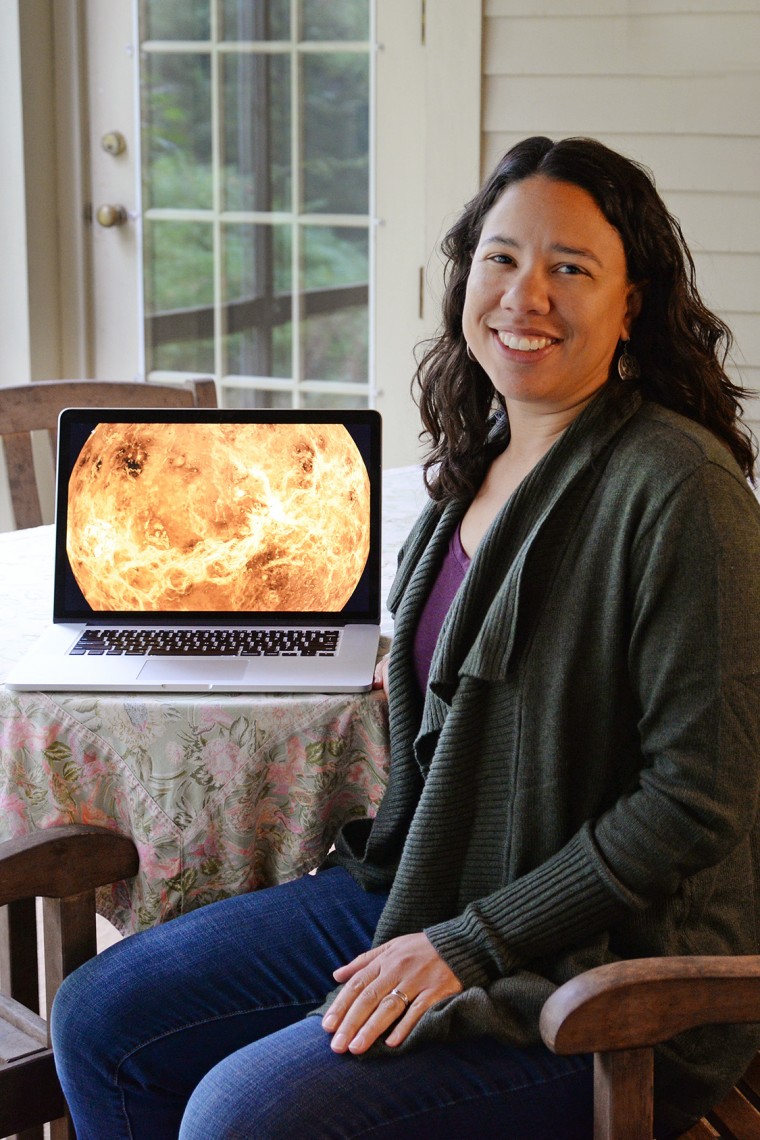
Two Discovery Program missions that University Professor of Earth and Environmental Sciences Martha Gilmore serves as a scientist for—DAVINCI+ (Deep Atmosphere Venus Investigation of Noble gases, Chemistry, and Imaging Plus) and VERITAS (Venus Emissivity, Radio Science, InSAR, Topography, and Spectroscopy)—received second-round funding from NASA on Feb. 13, 2020. The two missions, both focused on the study of Venus, were among the four projects selected by NASA for second-round funding. Each mission received $3 million from NASA.
Every 10 years, in a process called the Decadal Survey, two Discovery Program missions are chosen from those that receive preliminary funding to be completed. If DAVINCI+ and VERITAS are selected in the 2020 Decadal Survey, they will each receive $450 million to build a spacecraft and complete the proposed mission.
Both DAVINCI+ and VERITAS aim to investigate Venus to discover how and why the planet formed the way it did. Studying Venus has many implications on the formation and history of Earth, as Gilmore pointed out.
“One of the biggest questions we have is, ‘How do you get Earth? How do you make a habitable planet?’” Gilmore said. “And we know from studying planets that one of the key things that affects what type of atmosphere you have and how the planet evolves is size…. So the first thing we do is we look for a planet the same size as Earth in the hopes that that planet will be like our earth. And it turns out that the closest planet to us in the entire galaxy is an Earth-sized planet, Venus.”
DAVINCI+ is a mission designed to study Venus’ atmosphere in hopes of better understanding the planet’s formation as well as whether or not it ever had an ocean. If selected for funding, the DAVINCI+ spacecraft would be the first to enter Venus’ atmosphere since the Soviet Union’s Vega missions in 1984.
“It’s [the DAVINCI+ spacecraft] designed to go to Venus and then drop down to the surface and measure the atmosphere all the way down,” Gilmore said. “That’s really important because we only have a couple of measurements of the lower atmosphere of Venus, and that’s where all the action is with respect to how the atmosphere and the surface interact.”
Acting Astrochemistry Laboratory Chief of the NASA Goddard Space Flight Center Dr. Natasha Johnson emphasized that very little is known about Venus’ lower atmosphere.
“We don’t know what’s going on down there,” Johnson said. “It’s as if you are on the surface of [Earth] and the atmosphere below the tops of the Appalachian mountains, you know nothing about.”
Upon reaching Venus, the DAVINCI+ probe would take pictures of the planet’s surface while descending through the atmosphere. The spacecraft’s orbiter would also map the mineralogy of the surface to collect data that researchers could use to analyze the composition of Venus’ rocks.
VERITAS seeks to study Venus’ surface and the planet’s geological activity to investigate the developmental differences between Venus and Earth. Unlike DAVINCI+, a spacecraft with a descent probe and an orbiter, VERITAS has all of its instruments on a single orbiter.
“An orbiter is a satellite that orbits the planet,” Gilmore said. “[VERITAS] has the ability to look at mineralogy, but its main instrument is a radar instrument which would be able to make a map of the entire surface of Venus at a higher resolution than we’ve ever seen it before.”
Principal Investigator of the VERITAS mission Dr. Suzanne Smrekar of NASA’s Jet Propulsion Laboratory noted that recent developments in imaging and topography technology make the VERITAS mission a logical next step in the study of Venus.
“This mission came about organically,” Smrekar wrote in an email to The Argus. “Radar technology has advanced to the point that huge leaps in resolution and thus science are now possible, and the ability to do spectroscopy of the surface of Venus has recently been demonstrated. Together, this suite of measurements, high resolution topography, radar imaging, interferometric deformation, surface composition can address key science questions for Venus.”
Studying the geological activity of Venus is of particular interest to the VERITAS team because of the implications it may have on knowledge of Earth’s own formation.
“The entire surface of the Earth and it’s long term climate evolution is shaped by plate tectonics—the rigid plates that slide past each other creating mountains, volcanoes, and geology in general,” Smrekar wrote. “But all these processes began billions of years ago, so scientists aren’t sure how they began. These processes may just be beginning on Venus! By understanding the conditions that give rise to plate tectonics, we can understand Earth’s early evolution.”
Dr. Stephanie Getty, Deputy Director of the Solar System Exploration Division at the NASA Goddard Space Flight Center and one of two Deputy Principal Investigators on the DAVINCI+ team, also stressed the ways in which studying Venus could reveal information about Earth and other planets.
“It’s striking to think about how some models indicate that Venus once had oceans, maybe for as long as billions of years!” Getty wrote in an email email to The Argus. “This neighbor of Earth may have looked quite a lot like Earth in the past, so I think it is critical to understand Venus and its history when we try to answer questions about the prevalence of life and habitable environments, in our solar system and beyond.”
Sophie Wazlowski can be reached at swazlowski@wesleyan.edu.


Leave a Reply